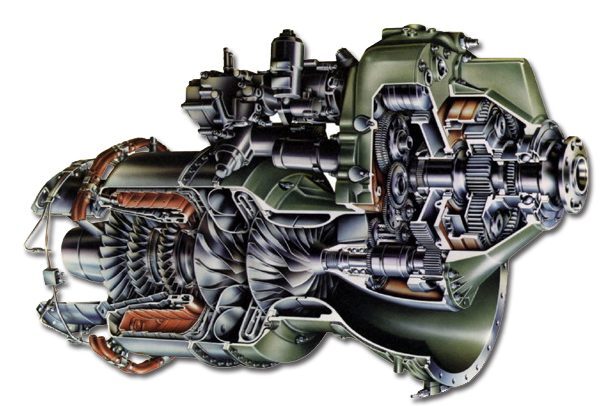By Mike Grabbe

Editor’s note: 2016 marks the 50th anniversary of the Honeywell TPE331 turboprop engine, and since its type certification in 1965 the engine series has grown to include 18 models and more than 100 configurations. Honeywell says it has delivered more than 13,500 TPE331 engines, which have logged more than 122 million flight hours.
The TPE331, which generates more than 1,000 shp in its latest iteration, is known for its fuel efficiency, its quick response to power changes, and its excellent performance, the result of its simple single-shaft design. The TPE331 has powered a wide variety of aircraft including all Commander turboprop models. Readers of Aviation International News magazine have awarded Honeywell the highest overall average score in the magazine’s annual engine product support survey.
Honeywell said it continues to work with airplane manufacturers across the aerospace industry to ensure the TPE331 will meet the needs of the aviation community for the next 50 years.
The company name has changed several times, from Garrett AiResearch to AlliedSignal and finally to Honeywell, but we die-hards still use the Garrett name, as we will for this article.
The 250-shp Model 231 engine project initiated in 1959 and evolved into a project known as the Model 331, a 330-shp engine, becoming the GTP331 440-shp APU. This design evolved into the TSE331-7 engine used in a Republic Lark helicopter, with flight tests beginning in October 1961.
Market developments led both P&W Canada and Garrett to the same conclusion at about the same time—that a need for a turboprop engine was developing. In 1963 development work began on a turboprop engine. The first TPE331-25, producing 575 shp, was test-run in July 1963. The first flight of a TPE331 engine on a fixed-wing aircraft was in April 1964. By 1965 a military version of the engine was flying in the OV-10 Bronco.
The official launch customer for new general aviation aircraft was Mitsubishi for the MU-2, replacing the original Turbomeca Astazou due to difficulties with that engine. Deliveries began in 1965. But, the first key commercial sale was to Aero Commander, in 1964. Garrett supplied the engine and flight inlet, and Aero Commander performed the installation on a 680FLP test aircraft, with Garrett performing the flight test work. First flight was December 31, 1964.
The first commercial versions of the engine were installed in the Volpar Super Turbo 18 commuter aircraft, Mitsubishi MU-2, and the Turbo Commander 680T. The engine was the TPE331-43, with deliveries of the 680T beginning in June of 1965. This engine evolved further through the -43B and -43BA engines. These engines had something that a young pilot or mechanic starting out today might not recognize on a 331 series engine—a compressor bleed valve. The valve was electrically controlled, opened at engine start to allow the engine to accelerate and closed at approximately 80 percent RPM.
Responding to the desire for more power, Garrett developed, among other versions, the -5 engine, certificated in 1970. The engine turns the propeller in a counter-clockwise direction, and in the process the compressor section was redesigned, eliminating the need for a compressor bleed valve. The change from the previous clockwise rotation to a counter-clockwise rotation was accomplished within the existing reduction gearbox envelope, reducing takeoff RPM (and noise) from 2,000 to 1,591.
The so-called Dash 5 engines were used in Commander models 690, 690A, 690B, 690C and 690D. One of the changes from the earlier engines was the shift from an EGT temperature monitoring system to an ITT system since it was not affected by ambient conditions, RPM, mass flow, etc. Over the years, design improvements were made—changes in fuel controls, the addition of an “EPA kit” that helped improve fuel nozzle life, and combustor redesign.
Again, to meet a growing desire for more power, Garrett provided a more powerful version of the engine, the -10, certificated in 1978. This version used the same compressor section as in the -5 series engines but incorporated a new hot section with bleed-air-cooled first-stage turbine nozzle and turbine disk assembly, and a redesign of the combustor. The engine also had an EGT monitoring system, but now with the use of modern computing power the cockpit indicating system could provide the pilot with a computed temperature indication—the SRL system—taking into account all the things that would skew the indicated temperature. The first -10 engines used the same five primary and ten secondary fuel delivery system as the -5 engines but suffered from some associated issues. The solution was to incorporate a system using 10 “piloted/air-blast/duplex fuel nozzles.”
Someone came up with the very good idea of offering users of the TPE331 series engines an improvement providing better performance and lower overall costs. The improvement consisted of grafting a -10 engine hot section onto an earlier version of the engine—for Commander people the -5 became a -10T—and in the process reducing the manufacturing parts versions. The -10T engine’s power output is kept the same as the original dash number, but the improved design allows for better climb performance and efficiency at altitude.
There would have been a -12 engine-powered Commander, but aircraft production stopped in 1984.
Mike Grabbe is Quality Control/Training Manager at Eagle Creek Aviation Services in Indianapolis.
